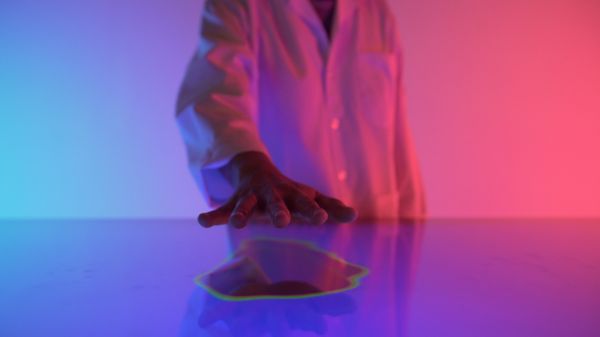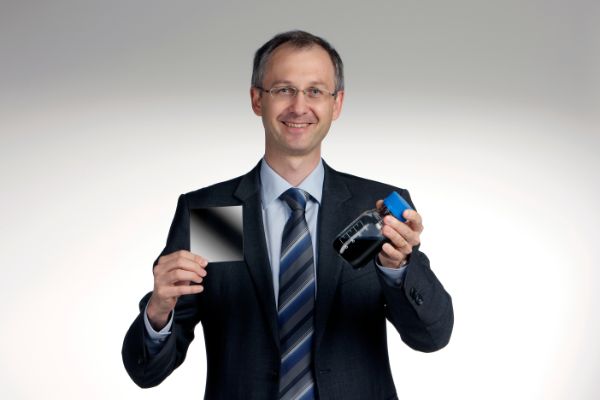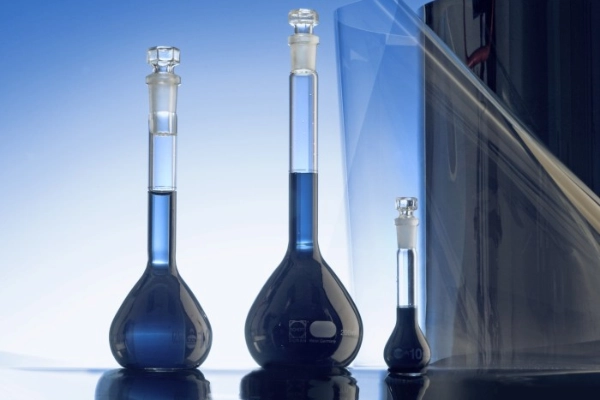Moving into new touchscreen size-dimensions with conductive polymers
The teacher stands at the blackboard and the students take notes in their exercise books: this is what everyday life still looks like at many German schools in the 21st century. Interactive whiteboards, which have been used sporadically, are technically complicated and very expensive. A much simpler solution for the future could be interactive, touch-enabled displays and whiteboards - a fully functional tablet the size of a blackboard, so to speak. Conductive polymers could help this new type of touchscreen achieve a breakthrough. Heraeus Epurio has developed the technology for this together with the US company SigmaSense and presented a particularly large prototype.
Polymer technology resembles newspaper printing
The reason why touch sensors can be found on every smartphone and tablet, but not on our TVs and only to a limited extent on digital whiteboards, is simple: it's the cost. "Previous technology was based on very complicated and expensive manufacturing processes and materials," explains Armin Sautter, Head of Technical Service Display at Heraeus Epurio. Here, the larger the device, the higher the cost. Conductive polymers from Heraeus would be ideal material candidates because they can be processed using simple and cost-effective wet coating processes rather than complicated and inefficient vacuum processes. It works much like printing a newspaper, except that instead of printing ink, conductive polymers from Heraeus are applied as a film to a foil. Until now, however, the conductivity of the polymers has not been sufficient for use in large touch sensors. A breakthrough has now been achieved with the innovative control electronics from SigmaSense, which enable the use of conductive polymers even in the largest displays.

These conductive polymers are a special type of plastic that can conduct electric current while being transparent in thin layers. They are characterized by outstanding optical properties and mechanical flexibility. Heraeus has already developed an entire product range for this purpose under the brand name Clevios. These polymers are not the typical solid plastic, but liquid polymer dispersions consisting of tiny gel particles that are stably distributed in water. This allows them to be applied flexibly as a thin film to substrates such as glass or foil. The resulting coating is highly transparent and about 200 times thinner than a hair. This makes polymers particularly suitable for use as sensors for displays. However, this requires a few tricks: "Applying liquids to a film is not easy. Additives must be added to ensure uniform wetting, good adhesion and long-term stability on the film," explains Sautter. Heraeus and Sigma Sense, in cooperation with other partners, have achieved this in a particularly impressive way with the prototype: the world's first 65-inch PEDOT polymer touch sensor. The basis for this was Clevios PEDOT:PSS technology.
Prototype as template for touch-enabled large displays
With the PEDOT polymer touch sensor, the display can basically do the same as a tablet as a TV, for example, and even a bit more. The sensor is so sensitive due to the SigmaSense electronics behind it that the touch display even works under water or with thick winter gloves. It can also be controlled via gestures ("hover") instead of touch, which is a particularly exciting feature in times of Corona.
The first real products could be on the market as early as this year. The new technology is likely to attract great interest not only in the education sector, but also at trade shows, in museums, at info points, in product marketing and in the television market. And according to Sautter, that's just the beginning: "I could also imagine desks that are one big display. Then meetings or video conferences with multiple participants would be much more interactive and easier to map than they are now."


